South Korea look like a team that can pose a serious threat in the 2023 Women’s World Cup, with a varied squad of experienced players of a high level, as well as a certain new generation that will seek to provide fluidity and different freshness in a fluid and direct game that Colin Bell has implemented in the Asian squad.
Sharing a group with Morocco, who are going to participate in the tournament for the first time, Colombia and Germany, they have a tough path ahead of them, but their proactive game in different phases of intensity and frenzy can also provide a lot of danger for their rivals.
This tactical analysis will give an explanation of their tactics and an analysis of what they approach in several phases of the game, in form of a scout report.
Predicted Starting XI
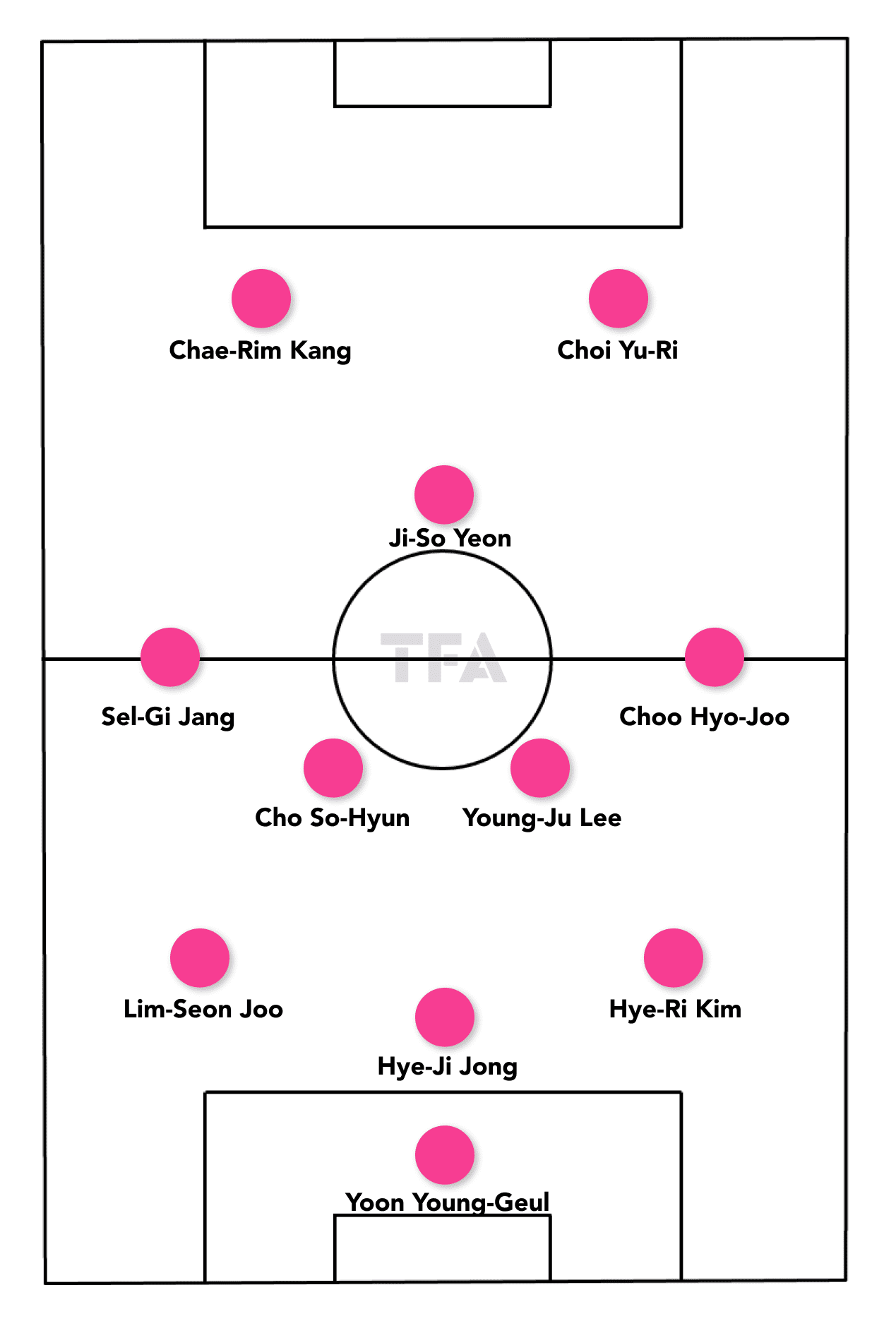
South Korea have plenty of talented and experienced players to compose the starting XI that will work for them in the World Cup. In their most recent friendly matches, they’ve used a 4-4-2 or 4-2-3-1 that varies from the 3-4-1-2 they had used in their recent competitive matches, in which we observed well-coached behaviours and principles, especially their build-up with the back-three and their double-pivot.
In the goal, we assume that the veteran Yoon Young-geul, the starter in most games, will be the regular goalkeeper during the tournament; The back-three would be made up of Kim Hye-ri, Jong Hye-ji and Lim Seon-joo, with Jang Sel-gi at left wing-back and Choo Hyo-joo at right wing-back, both with a much more offensive profile.
The midfield is one of the doubts regarding the team’s rotation, with the possibility of Cho So-hyun being one of the players with a ticket in the lineup over former Lee Young-ju. What is clear is that we will see Brighton’s Lee Geum-min on the field with former Chelsea’s Ji So-yun, the two possible best players on the Asian team.
Up front, Choi Yu-ri and Kang Chae-rim are two of the most used players in recent games. It will likely be them or a possible change between Geum-min as a CF and the entry of another midfielder to the double-pivot, as mentioned before.

Attacking Phase
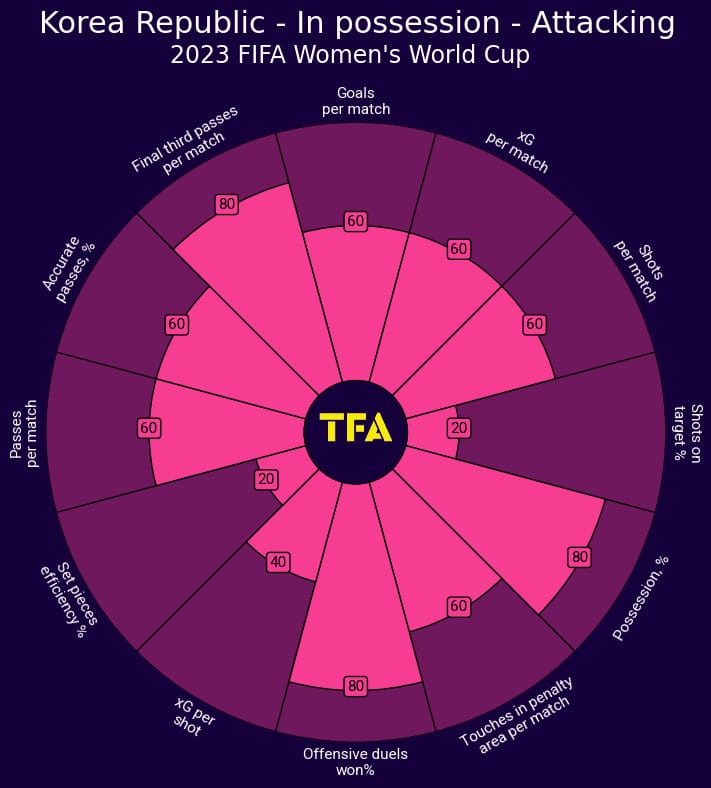
South Korea handles principles of direct football, managing the ball with one or two touches, with freedom in their players to drive/dribble, as well as offering a lot of mobility in each of its lines, especially in the front-two/three, which offers fluidity to the team’s possessions.
The first thing we should know about Colin Bell’s team is that they move the ball very fluidly; this is due to the different ways in which they seek to manipulate the opposing block, having clear intentions in the face of different adversity.
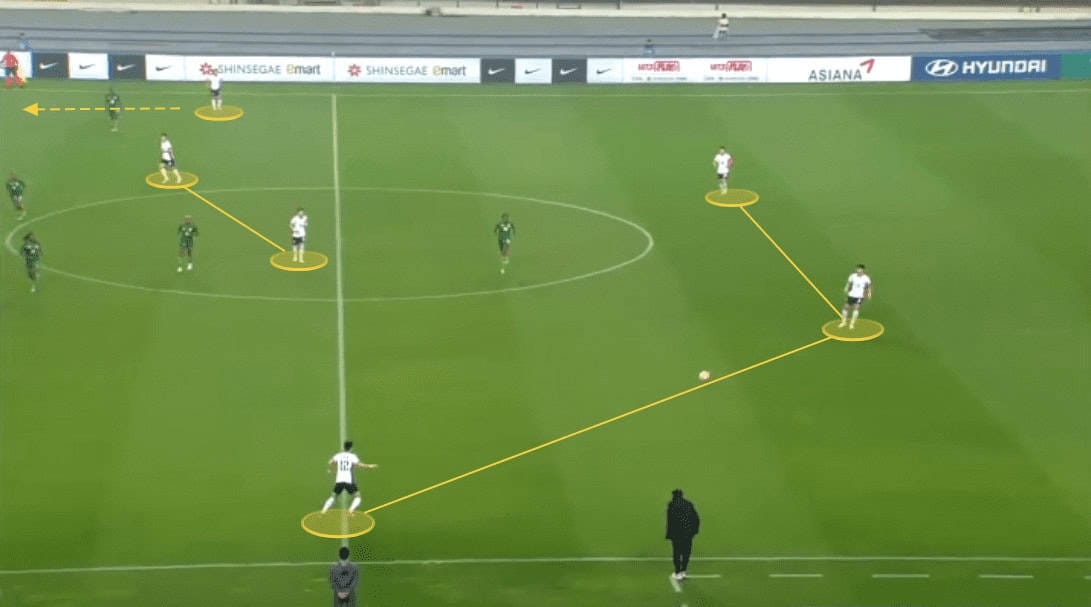
It’s a team capable of playing the ball low with patience, especially in the middle to dynamise, as well as working hard on their long balls into space or to feet, varying these deliveries.
Picture-3
In the image above, we can see the first automatisms of their back-three, which tend to gain width, seeking to fully stretch the opposing block so that the passing intervals open towards the middle with the double-pivot or to connect with more advanced players in half-spaces or central-channels.
The two midfielders vary their positioning a lot, rotating heights, but one is always lower and the other higher, almost in a diagonal line to be an option to play within their first touch and thus speed up with quick plays.
The two wing-backs raise their position to activate the wide channels like wingers and even act as such in their offensive ideas, carrying and driving/dribbling as well as crossing and shooting.
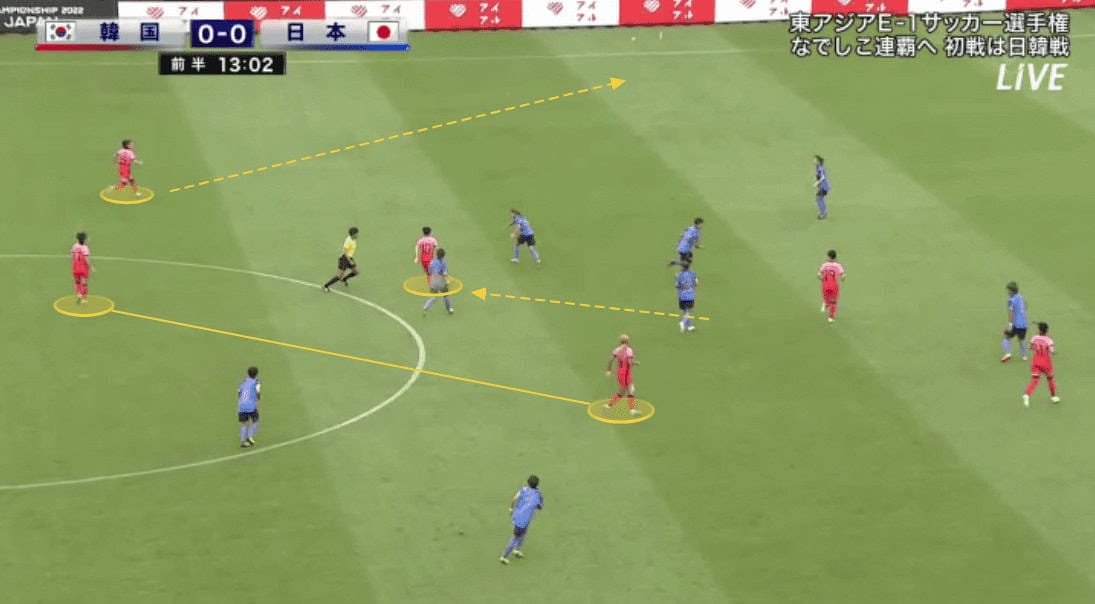
The context opens for the #10 in South Korea. With the width of the back-five and the moves of the double-pivot, the AM often drops to oxygenate build-up as well as finding passes only their vision can see.
She can sometimes be seen turning into tight spaces to carry the ball forward at high speeds. Much of what she does, however, is helping her team progress in the mid-third, connecting with tall wing-backs who have the freedom to drive and penetrate the box with long runs, as well as possessing the ability to do so effectively.
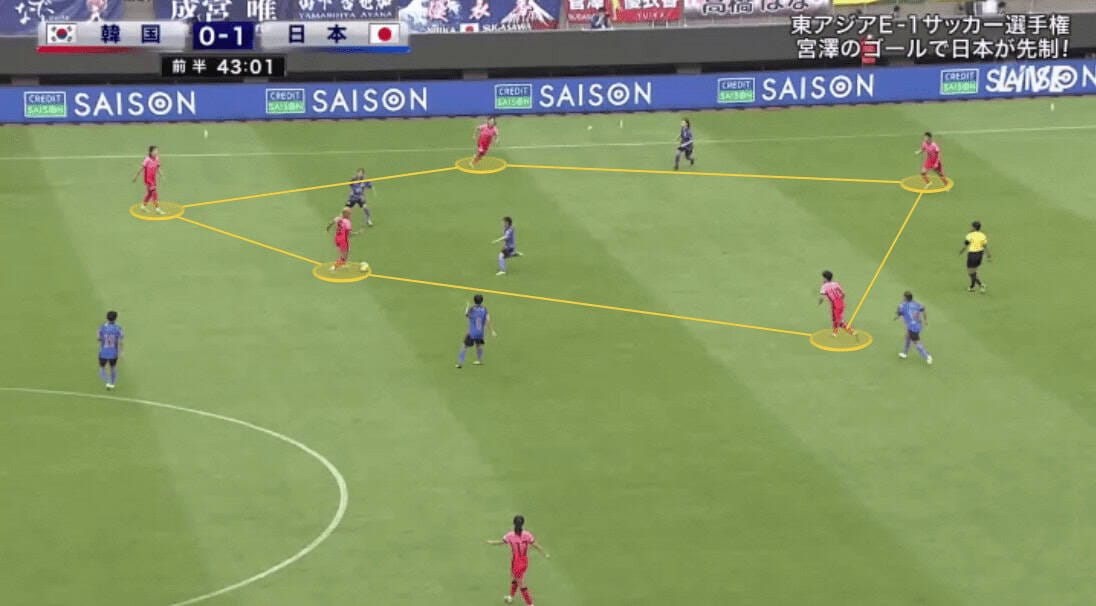
One of the most fluid ways in which South Korea handle the ball and manipulate the opponent is through triangulations on the flanks, joining even more than three players, with the centre-back initiating these quick plays, a defensive midfielder, the attacking midfielder and one of the centre-forwards joining together with the wing-back.
They seek to approach these flanks to make short space for their rivals, move the ball quickly and then drive to penetrate the box and send a cross to the two players who normally remain on the weak side looking to be activated.
These plays are made with one or two touches, always looking to end with a drive to release the pass closer to the penalty area.
This is used in different ways in the possession plays of the Asian team, the first to restart possession with a centre-back that will take advantage of the movement of the rival block to perform a long pass towards a wide-open player or going in-behind, as we can see in the first image below us.
On the other hand, as we talked about above — when they find the right moment, it is used to speed up with faster plays and get to the box to cross. Where there is always a centre-forward taking that central channel from the penalty area and another open one entering the far post.
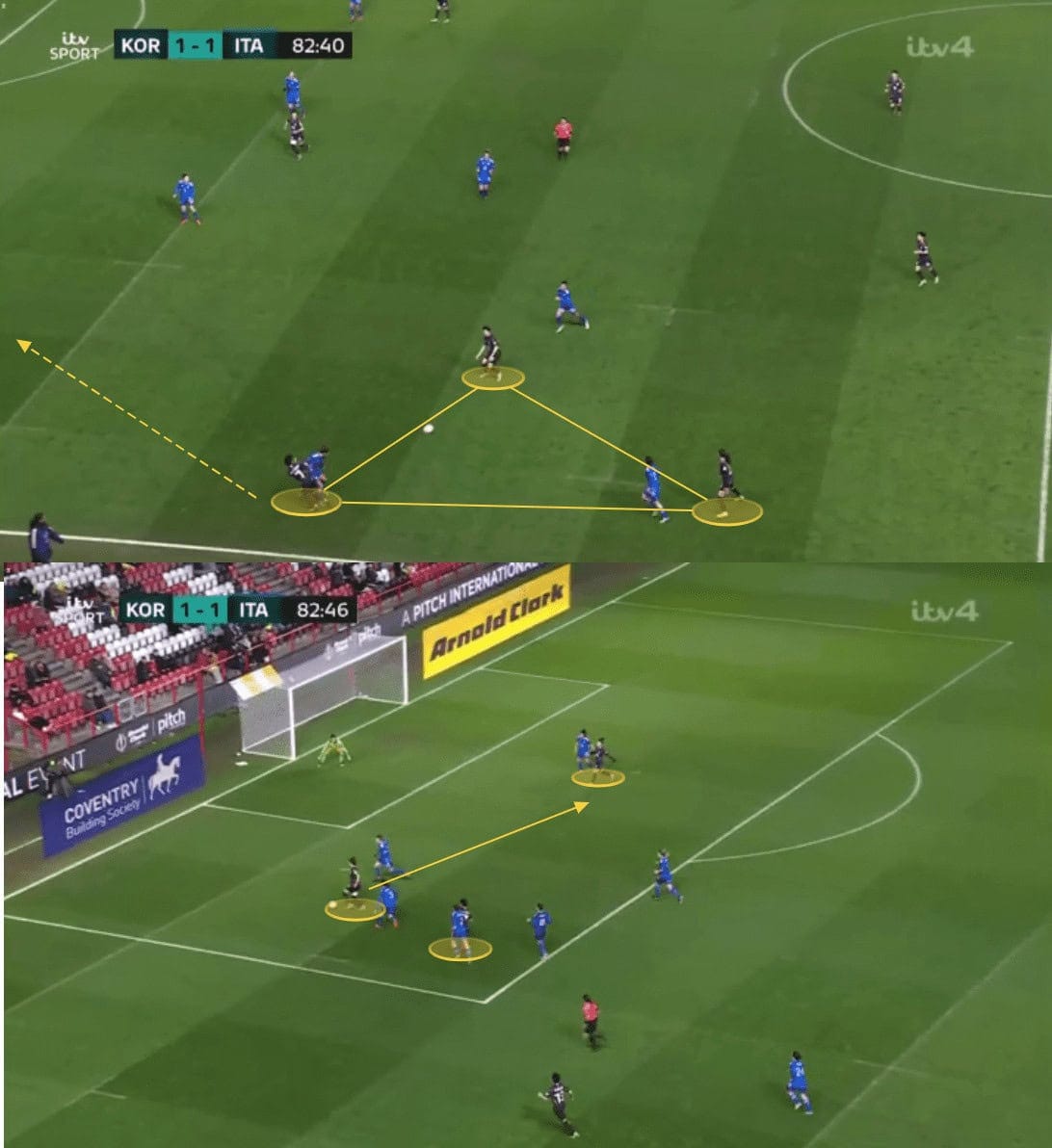
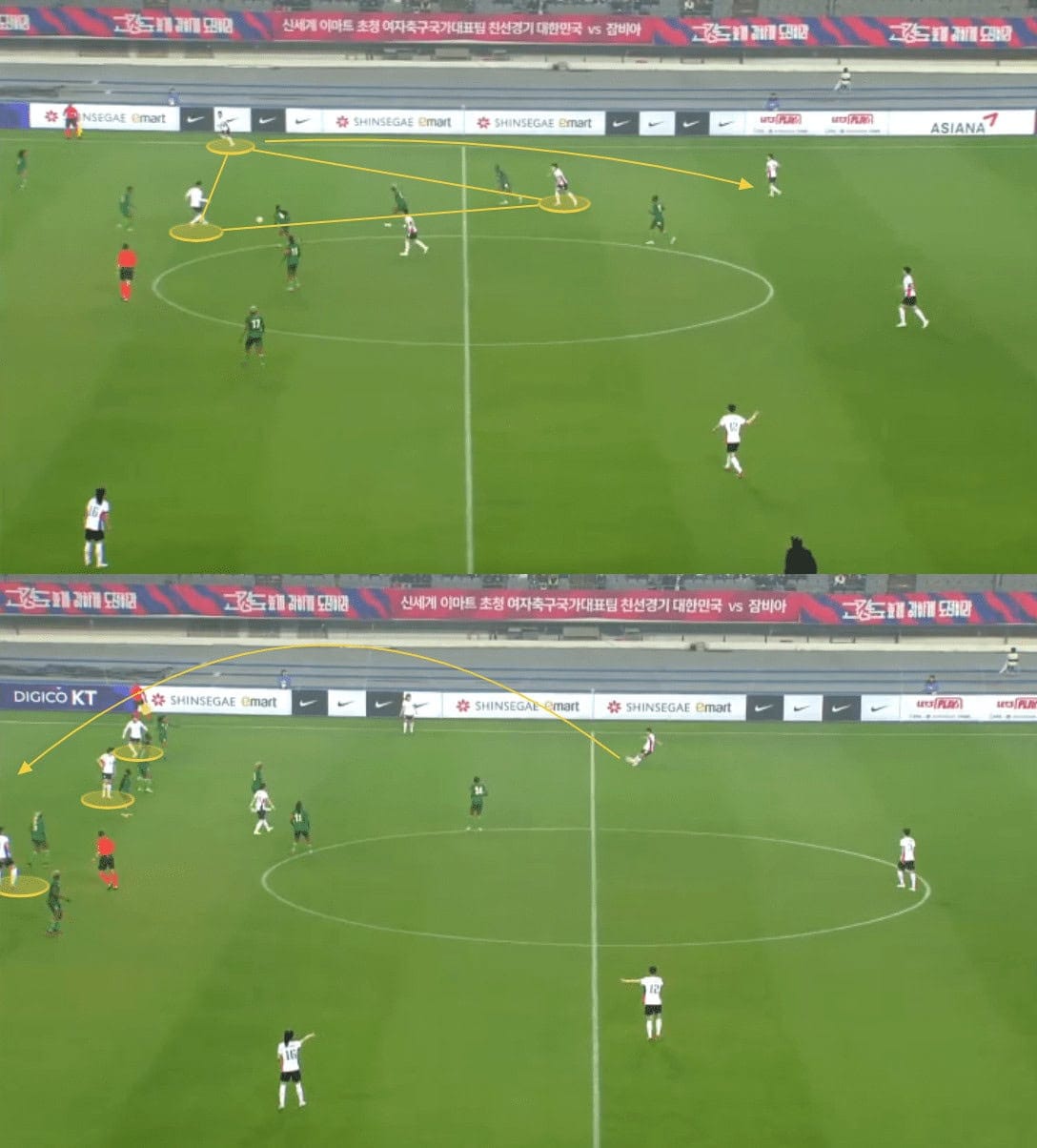
One of the most important principles of the South Korean team is what their central defenders can offer from their passes. They are usually aggressive and upright to find partners between the lines. All this is thanks to the positioning of her off-the-ball teammates which allows them to stretch the opponent.
Their executions go according to the midfielders, bringing the rival pressure low, almost next to the centre-backs where they recognize the moment to send a long pass to the wings or to the foot of the #10. As well as against low blocks, these passes get their team moving upfield quickly.
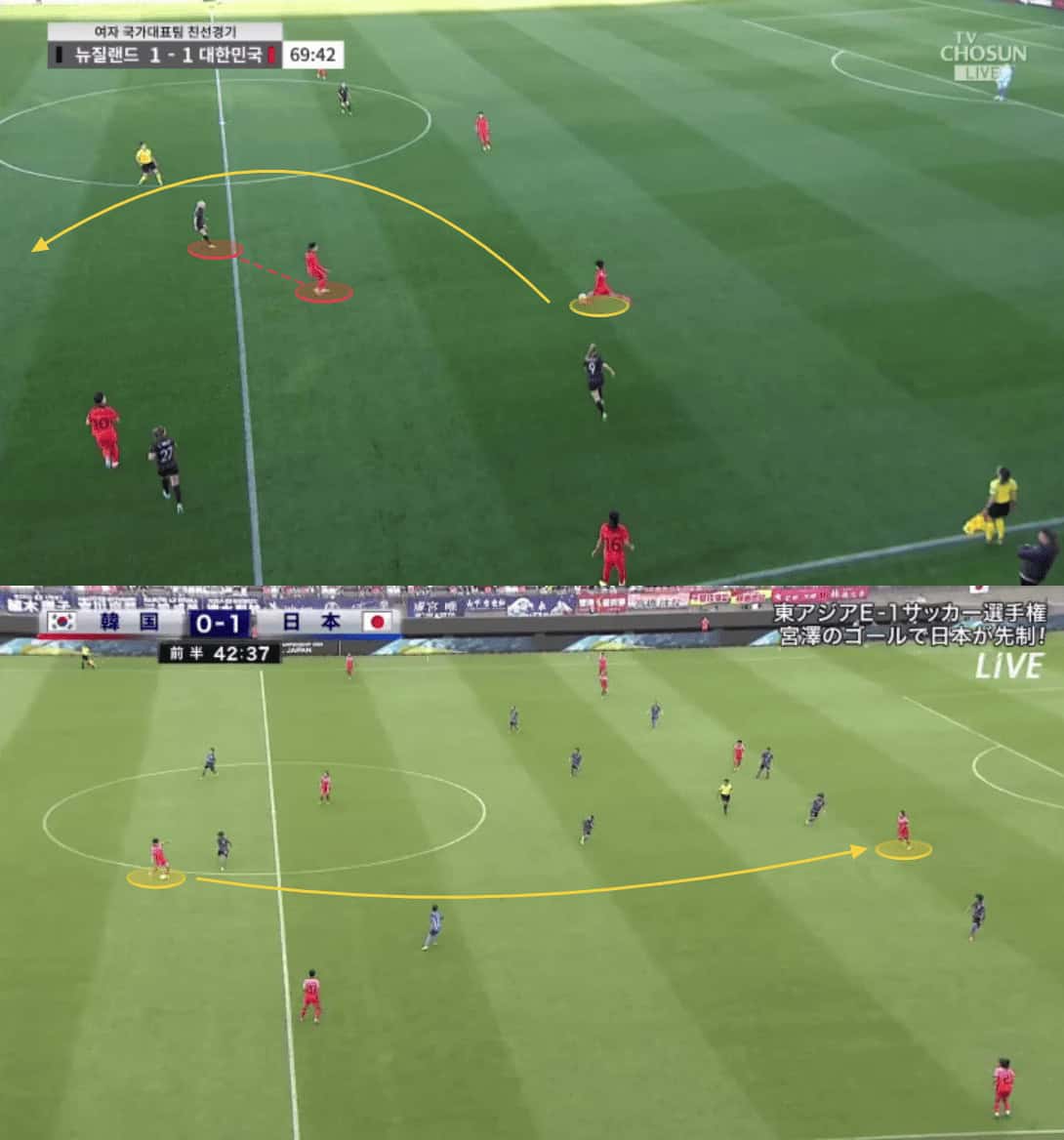
Defensive Phase
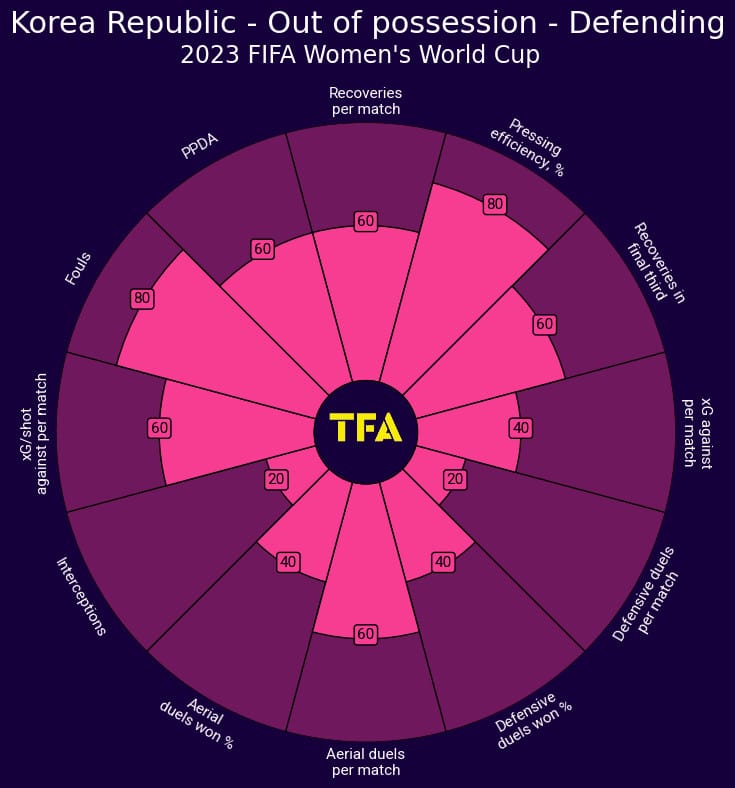
South Korea are a team that seek to attack and be proactive even when they don’t have the ball. They try to make the game short and narrow for their rivals with high pressure from good marking exchanges, being a mixed idea that opts for mid-runs to surprise the rival’s receptions.
The Asian team seeks to be aggressive from their front two or three, regularly including the #10, looking to cover the rival’s pivot, while the two forwards have the responsibility of guiding the ball to the sides where they try to steal with their runs.
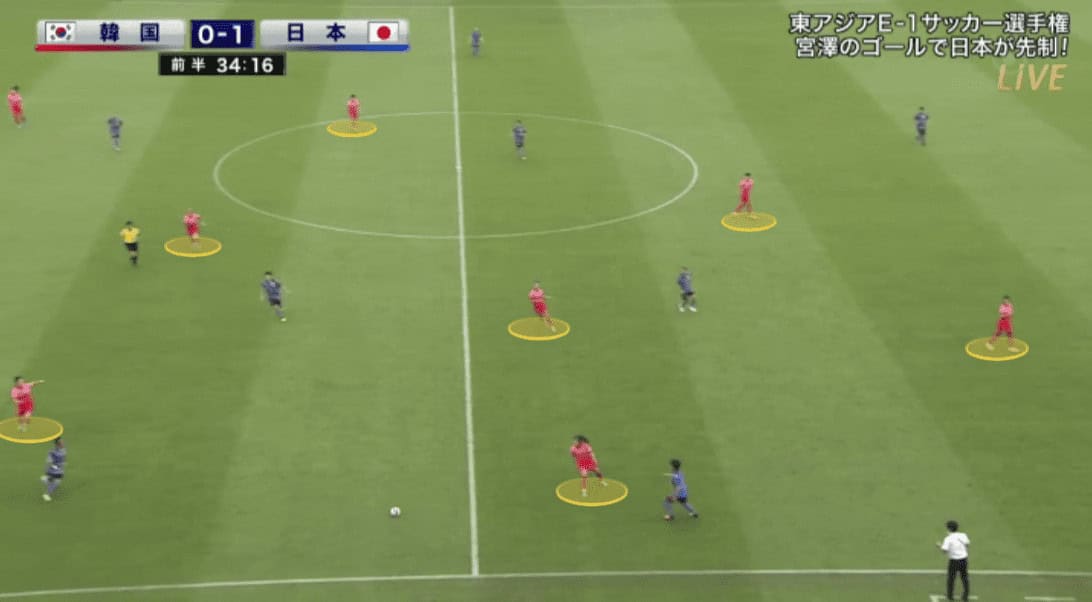
In the image above, we can find several automatisms that the team performs in their defensive block. The first thing we can see is that the markings are not tight, but rather waiting for the opponent’s reception to perform these runs, pulling the trigger at the right time.
In addition to this, a clear image of aggressiveness is that the last player in the image, on the right side, is coming to a duel looking to steal the ball. This is the RCB, with the RWB pressing forward almost like a winger.
The idea within this positioning and intention is that whether the ball is played by the opponent to the sides or from the inside out, they make the rival feel “comfortable” in a kind of pressing trap, seeing their teammates unmarked, but being surprised by the South Koreans that they pull the triggers properly.
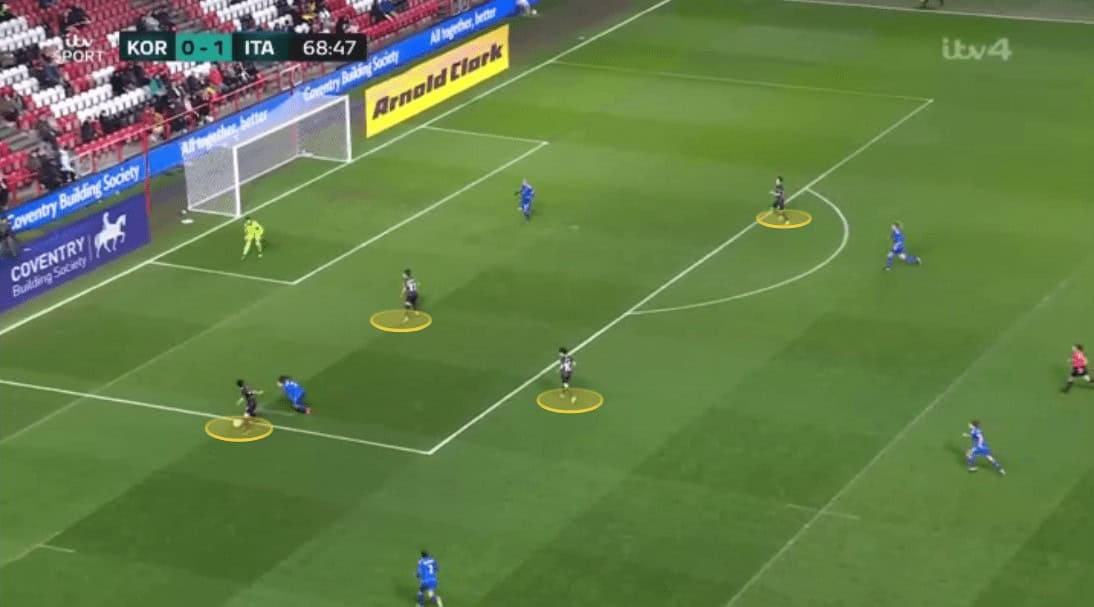
This high pressure has borne many fruits for South Korea. The main idea in this is to steal the ball as far from their penalty area as possible, blocking the opponent’s paths, making her ball movement stagnant and uncomfortable, through traps and intense runs.
It has favoured them in the idea of attacking off-the-ball, following the rival players until they manage to steal the ball high. As we can see in the image above, they have won the ball in the penalty box, where two more teammates are close, and one of them ends the play with a goal thanks to being concentrated and accompanying the high pressure.
However, it also has its counterpart, since sometimes it depends a lot on these surprising runs to defend from behind and the rival players take possession of their intelligence. Spaces where they can receive and thus shake up the rival lines of South Korea, making their CBs have to step off and leave many spaces in case the opponent executes a good pass or dribble.
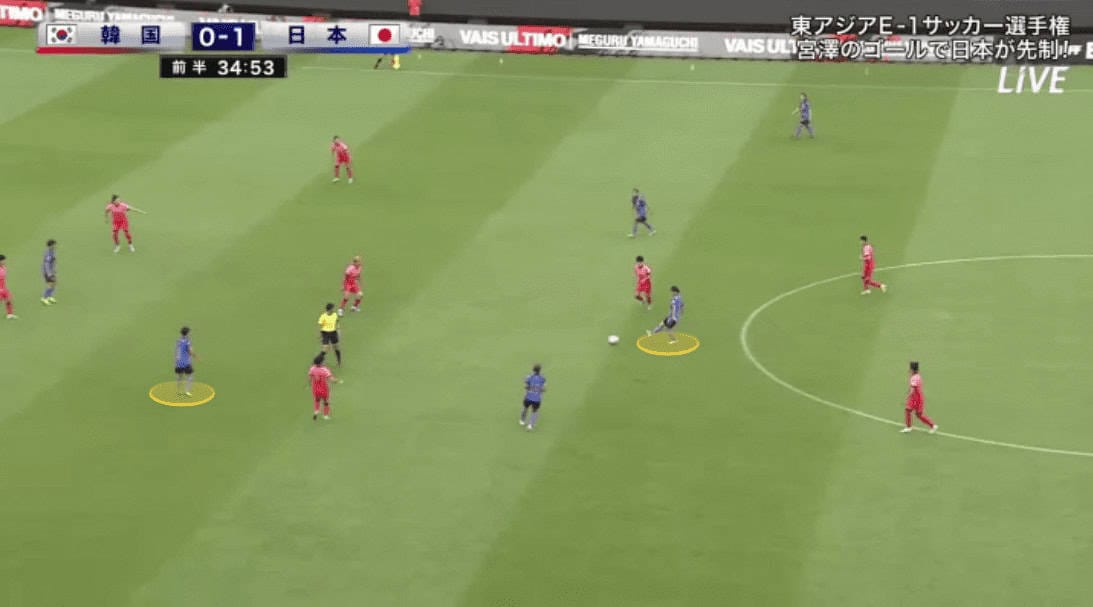
Transitions
Defensive transitions for South Korea have been a bit of a problem, which goes hand-in-hand with their proactive higher-pressing idea. When their press is broken, this frees up too much space in midfield.
This is due to what was explained in the defensive section of this article, where we talked about the lofty height the double-pivot takes, in addition to the entry of the #10 to defend in a front-three. This leaves the midfield with two very high, dependent on the aggressive coverage of their CBs behind.
In transitions, this works little, since if an opponent drives at high speed, the CB cannot make this decision to step off her line and free up even more space.
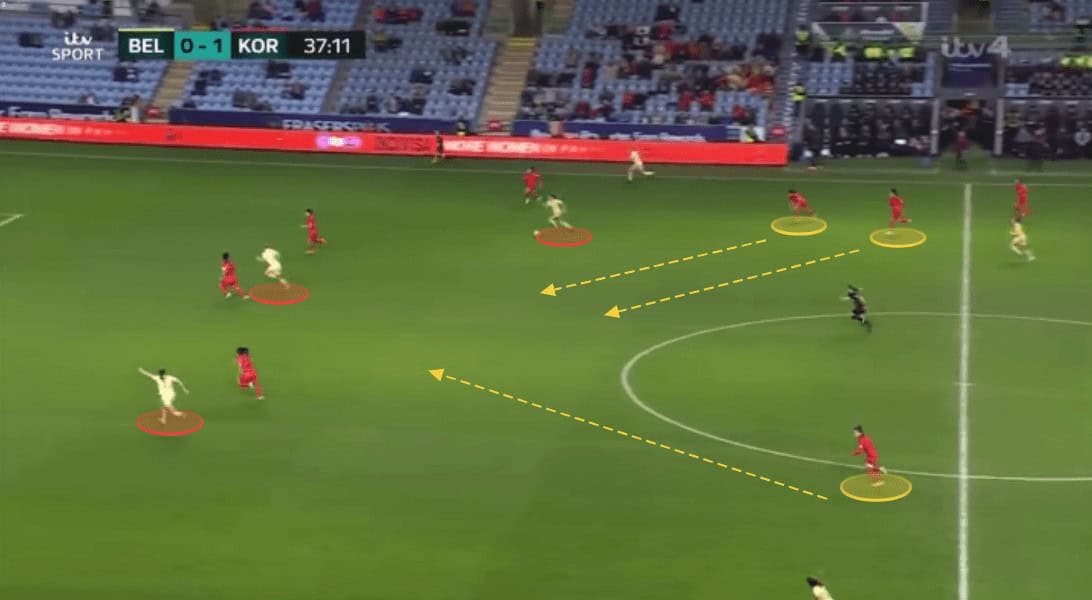
In addition, it can be constantly observed on these occasions, that the midfielders are so high that the recovery of the ball has to be done with long runs, which do not reach the edge of the box with the many meters that they must track backwards.
In the image below, we can see how the back three runs back to cover against three rival forwards, but no teammate has arrived to cover the space in the middle.
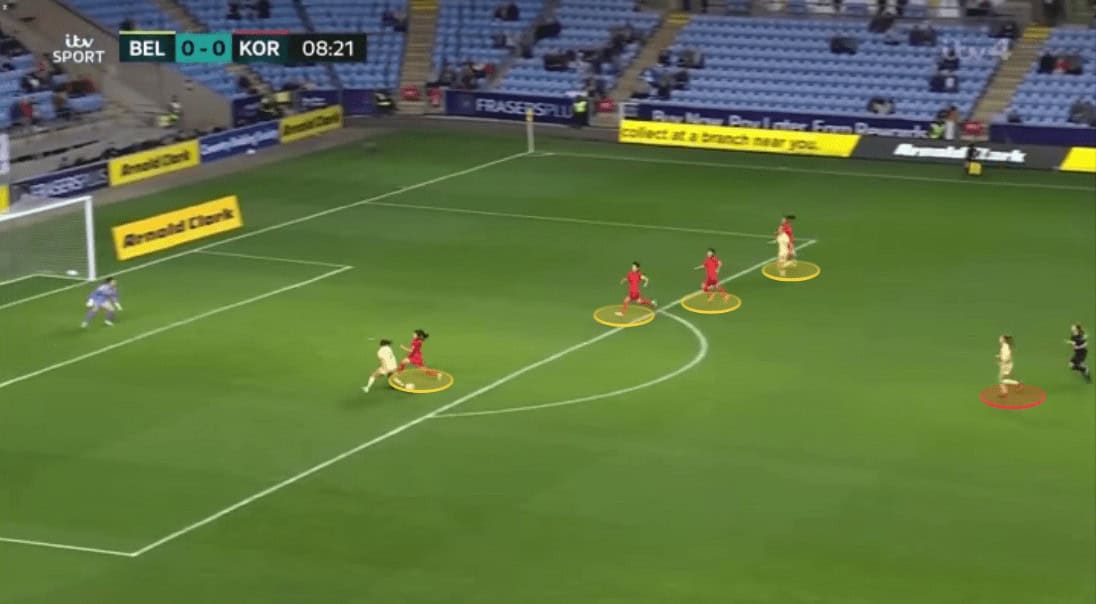
In attacking transitions, South Korea handles them well and with few variations, keeping it simple and understanding how to make them effective. Normally they seek to connect with the first player to make a run, not executing long passes but with a teammate who can take the ball nearby to drive it forward.
With freedom to carry the ball, this player is usually accompanied by one or two players who perform similar dismarking movements to the sides of the opposing defenders, exploiting the space behind them to receive almost in the final meters to finish off or cross it to the player at the far post.
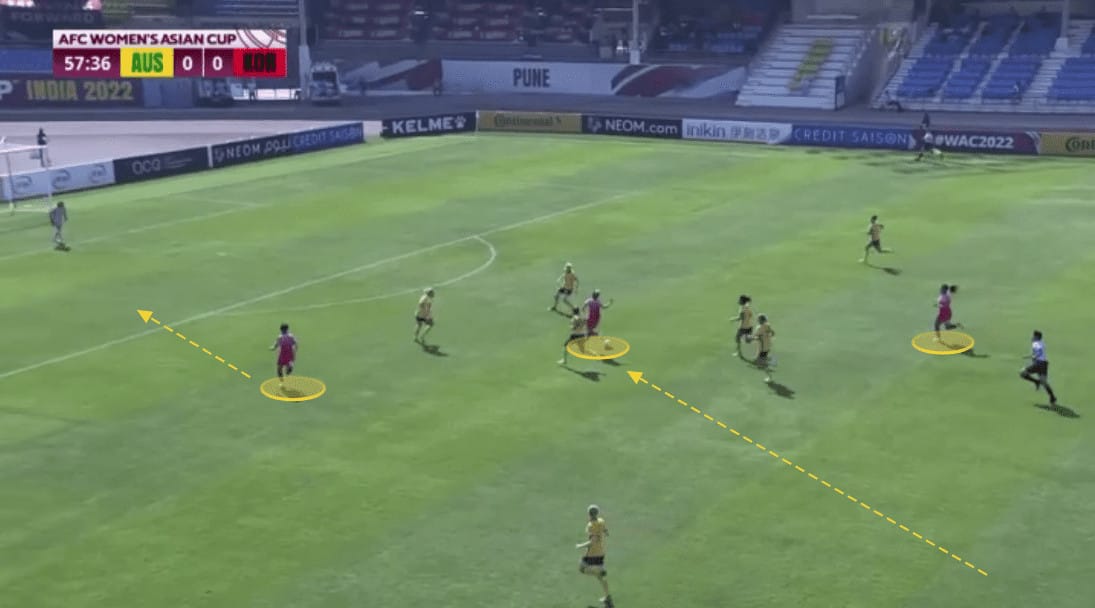
South Korea looks to be proactive in their intentions, which has a counterpart in defensive transitions where they will need to adjust against opponents as forceful as the ones they face in the group stage.
However, other teams will need to be careful with the fast runs with and off the ball when they’re looking to make their counterattacks effective.
Defenders
Yoon Young-geul will surely be the starting goalkeeper with a back-five consisting of Kim Hye-ri, Hong Hye-ji, Lim Seon-joo as the three CBs and on wide-channels Jang Sel-gi and Choo Hyo-joo. The substitute goalkeepers will be between Kim Jung-mi, Ryu Ji-soo and Choi Ye-seul. While Shim Seo-yeon will likely be relied on as a key backup option in defence.
Midfielders
Much of the game of the Korean team is based on the power, control and strength in the defensive phase that their midfield can provide, as well as possession management and changing the speed when they have the ball.
The possible regular names for the double-pivot are likely to be among Lee Young-ju and Lee Geum-min with others waiting on the bench such as Ji So-yun, Chun Ga-ram, Kim Yun-ji, Bae Ye-bin, Cho So-hyun and Chun-Ga-ram.
Attackers
In their provisional squad, Korea Republic showed their offensive intentions, calling different profiles in terms of age and roles they can fulfil on the pitch, as well as a large majority in terms of other positions. There are names like: Moon Mi-ra, Go Yoo-una, Kwon Da-eun, Park Eun-sun, Son Hwa-yeon, Won Ju-eun, Lee Eun-young, Jung Seol-bin, Choi Yu-ri and Kang Chae-rim.
Key Player
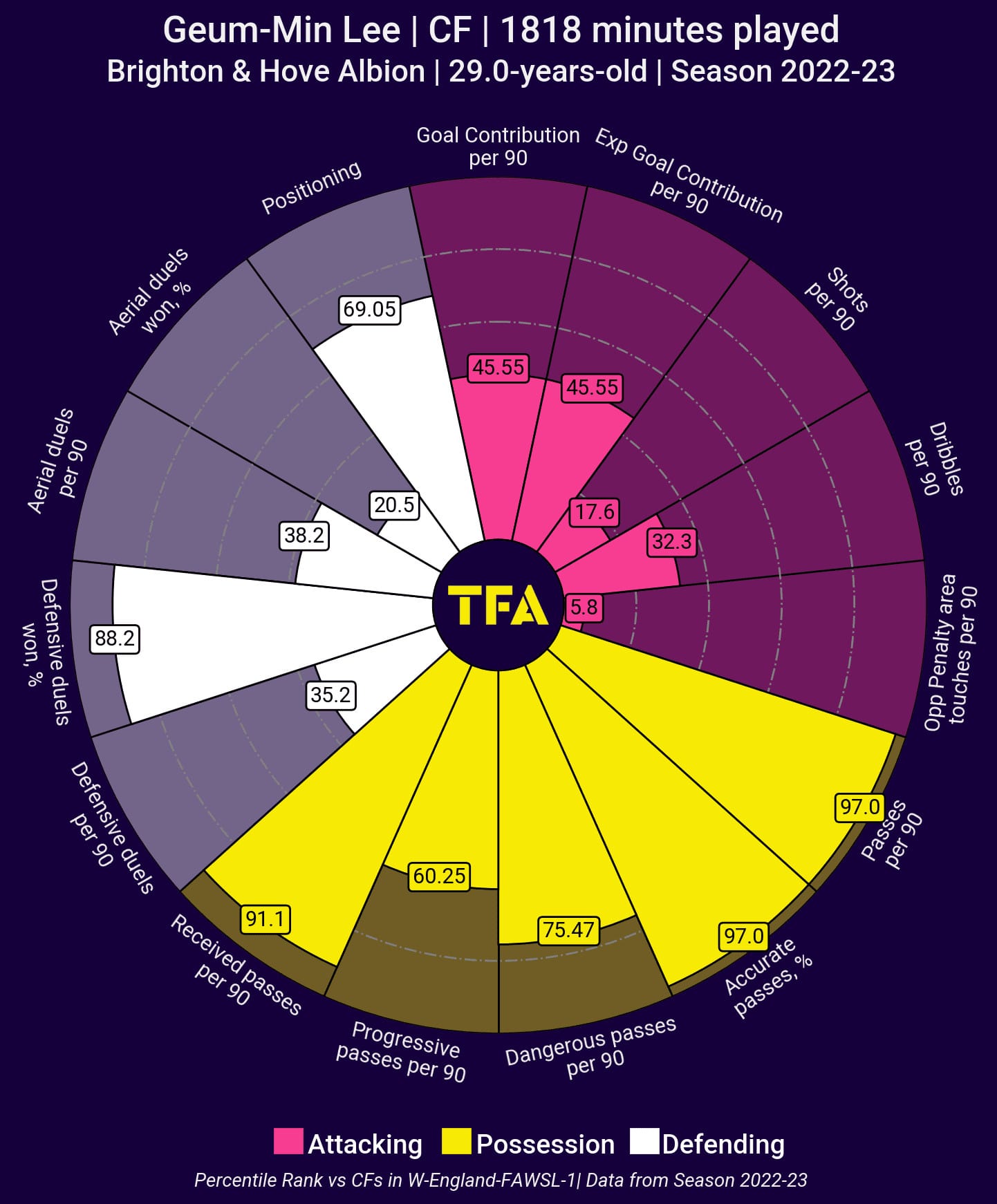
We chose Lee Geum-min, the Brighton player who shows a more than interesting level at 29 years old. Being able to play as a midfielder or attacker, acting at different heights and in the circulation of the ball in different ways, depending on the role that is given to her in the team in the World Cup.
It’s expected to see her both in the double-pivot, and forward, rotating positions with Ji So-Yun, the team’s common #10.
Tournament Prediction
South Korea will be in for a tough challenge with their experienced squad but also young, with up-and-coming talent looking to bring frenzy and fresher ideas to the starting XI rotation. With players like Ji So-Yun or Lee Geum-Min, in addition to the very interesting offensive and defensive idea that they have been building, it’s expected that they can battle against Colombia, Morocco and Germany.
It will not be easy against two teams as strong and with such big names as Colombia and Germany, however, their team effort and intensity could be key to qualifying for the next phase of the most prestigious tournament in Women’s Football.






Comments